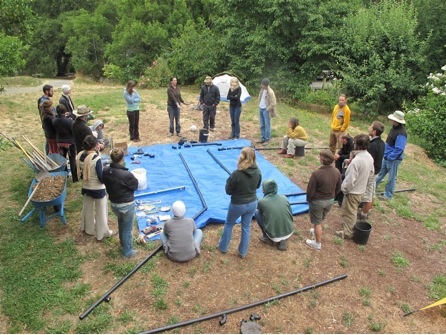Legal Graywater Design for Small-Scale Applications in California
By Kate Lundquist and Brock Dolman
Photographs by Brock Dolman
Table of Contents
Introduction
Project Description
Resources
Acknowledgements
We would like to thank Dean Witter for funding this project, Occidental Arts & Ecology Center, and the Sowing Circle community for supporting the implementation, Kendall Dunnigan for designing and managing the installations, Laura Allen for teaching the courses, and all of the Permaculture students who helped install these systems.
This report was written up by The WATER Institute at The Occidental Arts and Ecology Center in 2010. It is available for downloading on our website. Please consider giving a donation to support us in continuing this kind of work. Building upon OAEC’s many years of work to protect Coastal California’s watersheds, the WATER Institute concentrates on four interrelated program components: advocacy and policy development; training and support; education and demonstration; and research. For more information, contact us at (707) 874-1557 ext. 206.
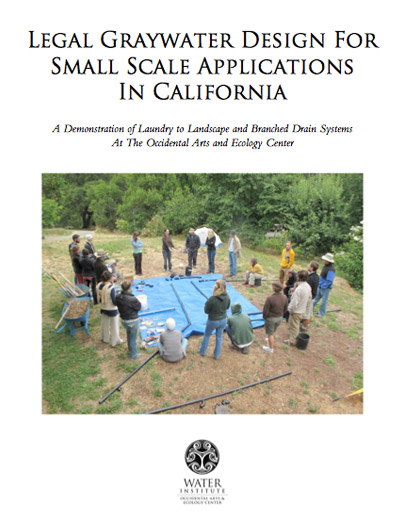
Introduction
As energy and water supply and infrastructure challenges continue to amplify in California, the State has identified points of both highest stress and greatest opportunity for change. In June 2008, Governor Schwarzenegger directed the Department of Water Resources (DWR) to take specific action to counter the statewide drought. New and amended statutes (passed through Senate Bill 1258 and effective January 1, 2009) now include requirements directing the Department of Housing and Community Development to propose to the California Building Standards Commission new standards for the construction, installation, and alteration of graywater systems for residential indoor and outdoor uses.
With new legislation approved, the Occidental Arts and Ecology Center (OAEC) is poised as a premier site in the Bay Area to demonstrate safe and effective use of graywater systems. Across California, many people are now looking for replicable models that are in compliance with the new building standards. Additionally, accountability to state enforcement and compliance will be needed to ensure that these new regulations are not compromised.
In 2009, OAEC’s WATER Institute received a grant from the Dean Witter Foundation to support the installation and demonstration of two styles of legal graywater systems on OAEC’s site. Graywater systems re-use water – for landscape irrigation or other purposes – that was previously used for shower, bath, sink, and laundry wash water. It does not include toilet or kitchen water. Now installed, these systems will substantially improve the drought preparedness of the OAEC site by reducing water demand for irrigation. They will also reduce stress on leach fields and reduce OAEC’s carbon footprint through lowered demand for electricity used in pumping “waste” water to leach fields. The benefits of these installations will be shared with the several thousand people who annually come to OAEC for tours, workshops, and events, as well as visitors to the WATER Institute’s webpage.
The installation and use of these graywater systems will support the WATER Institute’s ability to speak with the authority of practical experience as we continue participating in public policy processes at the state and county levels.
About The Occidental Arts & Ecology Center and OAEC’s Conservation Hydrology Adaptive Management Plan
The Occidental Arts & Ecology Center (OAEC) was established in 1994 by a group of biologists, horticulturists, educators, and artists as a 501(c)3 non-profit organizing and educational center, and organic farm in Sonoma County, California. OAEC’s programs combine research, demonstration, education, and organizing to develop community-based strategies for positive social change and effective environmental stewardship. For over thirty-five years, our site has been a sustainable agriculture training center, working with thousands of farmers, community and school gardeners, and farming activists.
OAEC has a long-established demonstration site, organizational expertise, and a proven track record of successfully implementing conservation hydrology restoration and demonstration projects. Since 2004, OAEC’s WATER Institute has been implementing an on-site Conservation Hydrology
Adaptive Management Plan that employs and demonstrates renewable energy technologies and best management and conservation practices for water, and for the energy associated with its use. These practical solutions include: roof water catchment systems, storm water management practices, a rainwater harvesting pond that supplies 100% of our irrigation needs, a solar thermal hot water system, bio-filtration to improve water quality, and a 10-kilowatt solar photovoltaic system.
WATER Institute Director Brock Dolman was a founding member of the Sonoma County Graywater Working Group. He is also an advisory board member of the Graywater Alliance, which has representatives from all the major graywater advocate groups statewide, all of whom were actively involved in the process of writing and adopting California’s new graywater standards code. Brock participated in public testimonial meetings held by the Department of Housing and Community Development in Sacramento for the development and approval of these new graywater code revisions. As a result of this work, Sonoma County adopted the State’s graywater standards codes with no further restrictions. This means that anyone in Sonoma County can install a Laundry to Landscape (or Clothes Washer) system with no permit or a Branched Drain system with a plumbing permit.
Project Description
In 2010, OAEC installed two types of low-tech and cost-effective graywater system designs that meet the newly passed state and county emergency graywater code regulations. These designs were chosen based on the needs and topography of OAEC’s site, and are in compliance with the new graywater code revisions. We installed three “laundry to landscape” clothes washer systems, and two “branched drain gravity” graywater systems, each supplied by a single fixture shower/bathroom sink. The design for each system met the required guidelines of the new graywater plumbing code (see the Sonoma County graywater brochure).
System # 1 – The Laundry to Landscape (Or Clothes Washer) Graywater System:
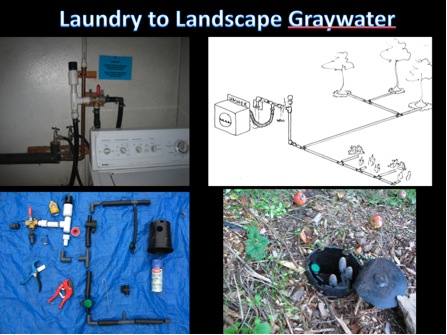
An original design (developed by Art Ludwig of Oasis Design) is the simplest, least expensive way to get the most graywater out onto the landscape most effectively. Due to its inherent simplicity and low cost, it is a design that promises to be best suited to professional installation by landscapers and homeowners. The pressure developed by the clothes washer’s own pump effectively distributes graywater throughout the landscape.

Lessons Learned:
Overall, these systems are functioning well. The following was observed, and necessary adjustments made:
- The end plug on the l” distribution lines was clogging easily due to the debris in the wash water (lint and hair). They were removed so nothing can obstruct the water when it discharges into the mulch basin shields.
- Originally, we used 1-gallon pots (tall and narrow) to create the mulch shields in the mulch basin (see photo above). It turns out that these were getting clogged more easily and not draining well. We replaced these with wider 5-gallon pots that have their tops cut off. The wider circumference increased the surface area of the mulch that receives the debris-laden discharge and improved drainage into the surrounding mulch basin.
- We constructed the mulch basins out of the wood chips we had on hand, which were of a fine texture. This sped up the composting process and required that we replace the chips sooner. Had we used coarser wood chips, we would have had to replace them less frequently.
- The decomposition process, aided by volunteer native Inky Cap mushrooms (Coprinus sp.), yielded a rich black soil.
- This rich soil increased the diversity of the soil food web that became attractive to foraging raccoons. They would unearth the mulch basins and shields in search of worms and other earthly delights. The solution was to affix the shields to large wooden stakes pounded into the mulch basins.
System #2 – Branched Drain Gravity Graywater System:
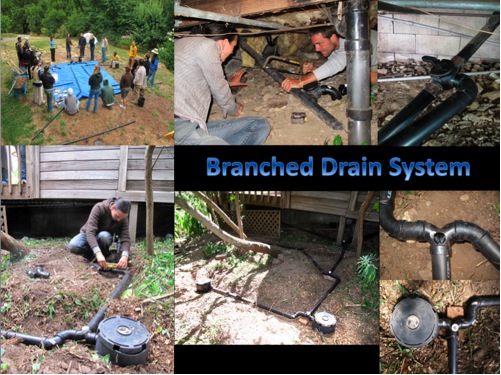
This design offers inexpensive, reliable, efficient distribution without filter cleaning. It utilizes gravity pressure from a shower or sink, and a continuous downhill slope from the points of graywater generation to the points of irrigation need.
Lessons Learned:
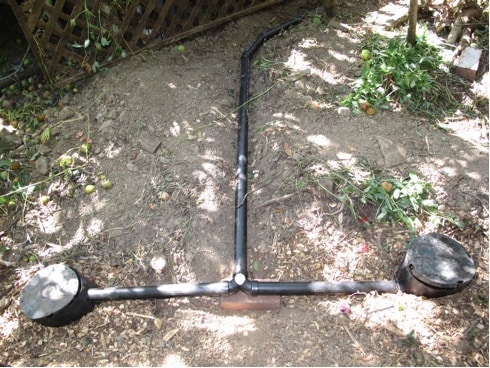
- Branched drain systems require significantly more trenching and careful design work to install. Because they depend on gravity for flow, they require close attention to the placement of pipes in relation to the slope.
- Flow splitters must be installed on the level (see photo above) to ensure even distribution of water throughout the system.
- Based on what we learned from the Laundry to Landscape systems, we used the cut-off 5-gallon mulch shields for the mulch basins (see above Laundry to Landscape Lessons Learned for details).
- It is important to determine which pipe and where to cut into the house’s plumbing system to install the three-way valve so that you do not compromise the venting of the existing plumbing nor contaminate your graywater by cutting into the blackwater lines. This is why a plumbing permit is required to modify the drainage system.
- Always make sure you have adequately identified any underground utilities before digging trenches.
